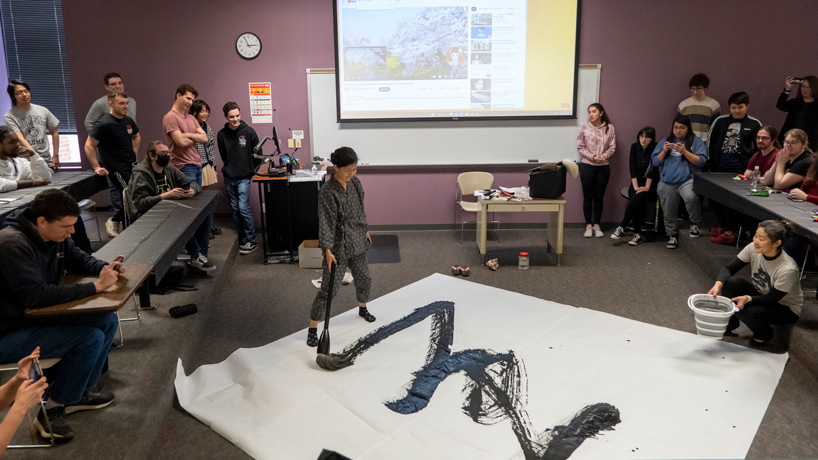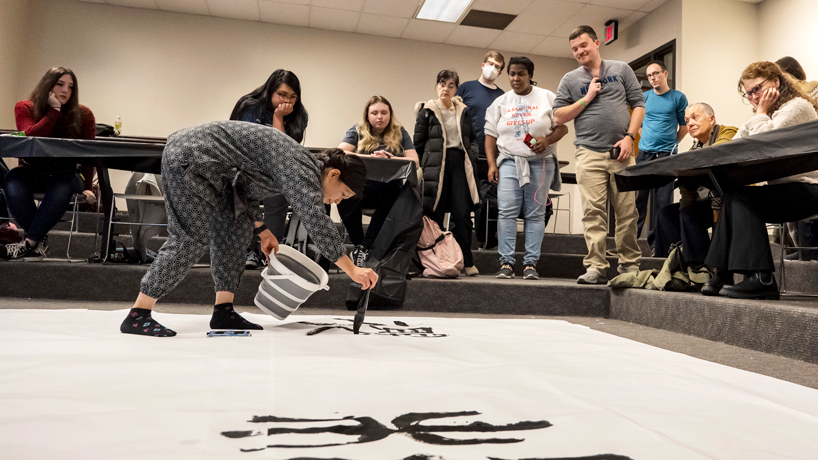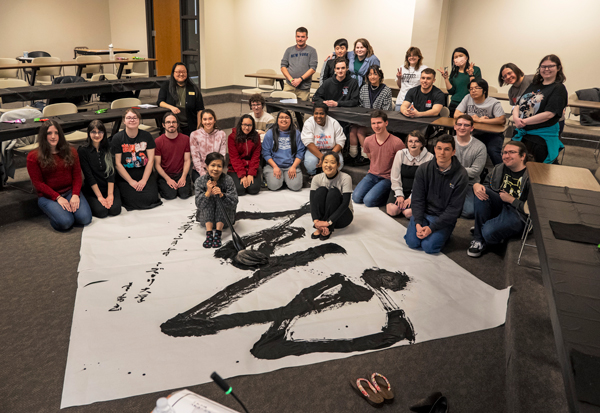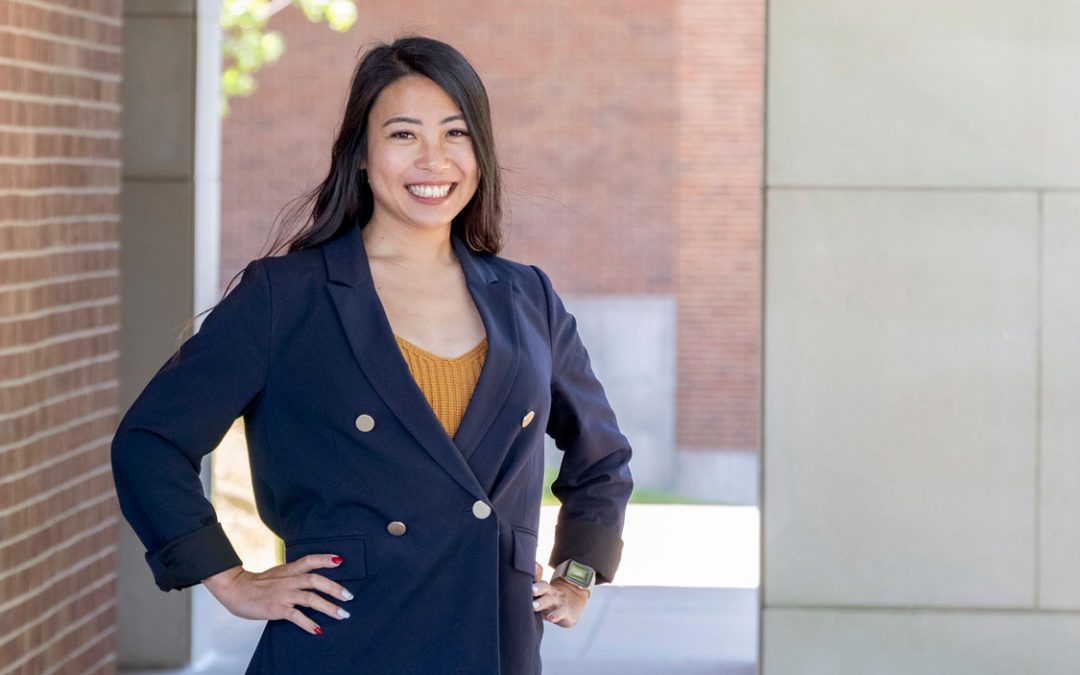
Japanese calligraphy master Kaori Ishijima uses a large brush and bucket of ink to craft a giant Japanese letter representing “spring” as members of the UMSL community watch her work. The event drew about 40 UMSL faculty, staff and students and included a lecture about Japanese calligraphy, three large-scale calligraphy performances by Ishijima and a hands-on calligraphy workshop led by Assistant Teaching Professor Hiroko Yoshii. (Photos by August Jennewein)
Tuesday afternoon in Social Sciences and Business Building 132 at the University of Missouri–St. Louis, Kaori Ishijima glided gracefully over a piece of calligraphy paper the size of a tarp while an audience watched with rapt attention.
Expertly handling a giant brush laden with ink, she made artistic strokes several feet in length, sometimes necessitating quick steps across the delicate paper. Eventually, the strokes came together to form the Japanese letter representing “spring.”
Ishijima’s performance was part of a series of events for National Foreign Language Week hosted by the Department of Language and Cultural Studies. The event drew about 40 UMSL faculty, staff and students and included a lecture about Japanese calligraphy, three large-scale calligraphy performances by Ishijima and a hands-on calligraphy workshop led by Assistant Teaching Professor Hiroko Yoshii.
Yoshii teaches Japanese and is also a calligraphy practitioner. She began learning the art form during elementary school in Japan and has practiced regularly over the past six years. Last year, she began taking calligraphy classes led by Ishijima, who has been teaching and performing for more than 40 years.
A large-scale performance is something Yoshii has always wanted to bring to campus, and she successfully secured grant funding to make it happen this semester. Yoshii was thrilled by the turnout and the response to Ishijima’s work.
“I am overjoyed right now to see everyone’s excitement,” Yoshii said. “They were so drawn to the performance and so excited. The performance was able to demonstrate the Japanese culture to students not learning Japanese – a wider community – so that was a great part, as well.”
Several of the audience members had some familiarity with the art form, which spurred them to attend the performance. Kelsey Coulter, a sophomore Japanese major, and Hunter Stiefvater, a senior computing technology major, had both taken a beginner’s calligraphy course at UMSL taught by Yoshii. Cecilia Fischer, a senior Japanese major, had previously attended a calligraphy workshop event led by Yoshii, as well.
Coatler, Stiefvater and Faith Zuber, a senior Japanese major, were interested in a observing a master of the craft. Zuber added that she thought of it as a “once in a lifetime” opportunity.
“I was very excited to see the large brush demonstration because it’s something that’s always seemed exciting about the topic of East Asian calligraphy,” Coatler said.
Before beginning her performance, Ishijima led a presentation, which Yoshii translated into English, about the history of Japanese writing styles and the core values of practicing calligraphy.
Kaori Ishijima draws the Japanese letter for “cherry blossom” in five styles of script.
Ishijima explained that Japan has three writing systems: Kanji, Chinese characters that likely came to the country with the spread of Buddhism; Hiragana, characters that evolved from Kanji; and Katakana, characters derived from individual components or fragments of more complex Kanji. Additionally, calligraphers utilize five primary styles: seal script, clerical script, block script, semi-cursive script or cursive script.
No matter the style, practicing calligraphy provides valuable lessons in concentration, posture, patience and composure and critical thinking.
“You have only white blank paper, so you have to think where to start and where you go,” Yoshii said. “You have to calculate and estimate where to go beforehand, so it requires critical thinking.”
As an avid artist, Zuber found that principle particularly meaningful.
“Calligraphy is helpful for space management,” she said. “I do like to draw, and I’m terrible at space management. So, calligraphy would be a nice way to practice that, I think.”
After concluding her presentation, Ishijima began her first demonstration, composing the same Japanese letter in each of the five scripts. She quickly entered a rhythm, making deliberate brush strokes on the paper spread across the floor, then taking a step back to survey the remaining space. As Ishijima worked, she encouraged the audience, many of whom were Japanese students, to guess what she was writing. Eventually, someone exclaimed “Sakura,” which translates to cherry blossom in English.
For the second piece, Ishijima transcribed the lyrics of “Sakura Sakura,” a traditional Japanese folk song depicting spring and the flowering of cherry blossoms. She then moved on to the finale, which required a bucket of ink and a brush that nearly came to her hip.
Kaori Ishijima (front left), Hiroko Yoshii (front right) and a group of attendees pose for a photo with one of Ishijima’s finished pieces.
Ishijima used both arms to steadily guide the large brush as she crafted a huge “spring” letter. Coatler and Fischer found that they were transfixed by how the brush moved on the paper and how Ishijima was able to subtly create an array of different lines. Stiefvater was impressed with Ishijima’s dexterity with the large brush.
“It was really interesting to see just how it works – how you have to use your whole body to move it,” he said. “It really showed how good she was. I don’t think I could have done it.”
The event wrapped up with Yoshii leading a hands-on calligraphy workshop for the attendees. Each person received a brush, ink and sheets of paper to practice creating the “spring” letter in block script.
Yoshii instructed everyone to keep good posture, hold their elbows up and position their brushes upright. She also reminded the room that retouching any strokes of the brush was discouraged in the spirit of “ichigo-ichie.” The Japanese phrase is often translated as “once in a lifetime experience” or “seize the day,” which encourages people to appreciate the moment.
After the workshop, everyone pitched in to help clean up the space. Yoshii was thankful for everyone’s enthusiasm and willingness to work together, even in tidying, which she said exemplified the ideals of Japanese community.
Artwork in hand, Fischer said she appreciated the opportunity to become more familiar with the art form.
“It’s really fun to explore how to accomplish a goal with it because the brush can be slightly hard to control,” she said. “But once you get the hang of it, it feels really thrilling and feels like you’ve accomplished something really big even though you’ve just made a line on a paper.”
















